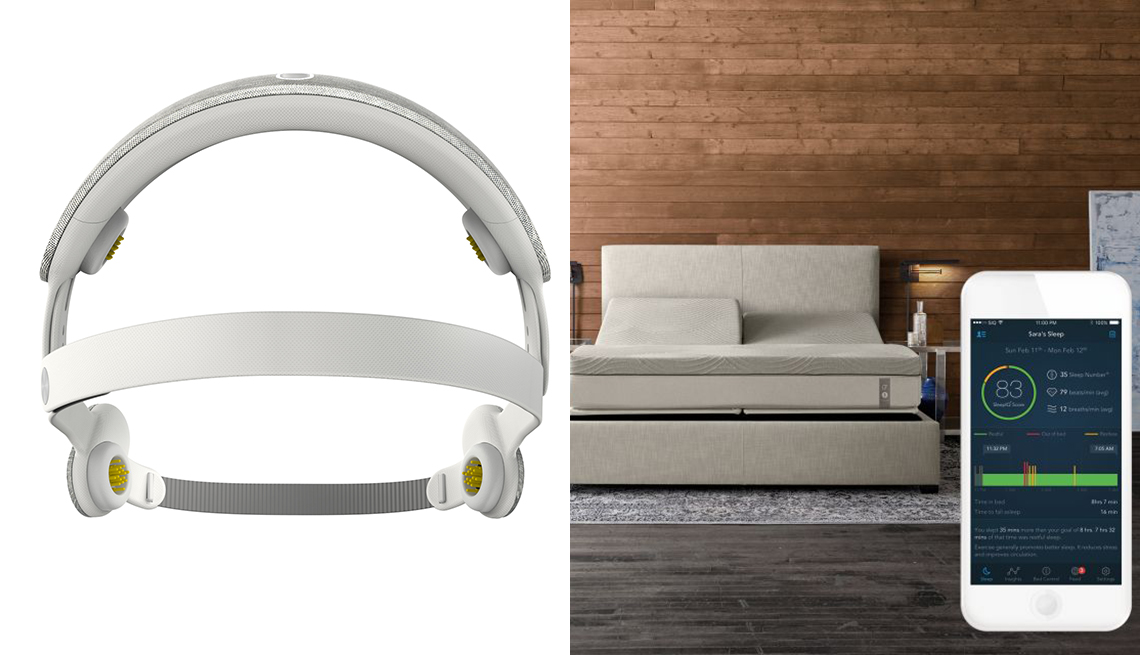
The (sleep) bands are back in town
- Select a language for the TTS:
- UK English Female
- UK English Male
- US English Female
- US English Male
- Australian Female
- Australian Male
- Language selected: (auto detect) - EN
Play all audios:

As America ages, the demand for sleep technology is booming: The sleep-tech section at CES 2019, the consumer electronics trade show, was 22 percent bigger than in 2018. “People over 50 are
our largest group of users and the most engaged,” says SleepScore Labs CEO Colin Lawlor, who counts himself among the demographic suddenly worried about the quality of their slumber as well
as the linking of poor sleep to increased risk of conditions like dementia, obesity and hypertension. To improve your odds, SleepScore’s free app uses sonar to measure your breathing and
movement while dozing. “It’s like a bat using echolocation,” Lawlor says. The app then rates your sleep quality and recommends one of the more than 70 products curated by its experts, which
vary from blue-light-filtering glasses (all the better for watching TV before bed without disrupting your natural melatonin production) to Snore Strips (which Lawlor says are effective for
about 20 percent of those who try them; SleepScore can advise you if they’re for you). “This is all about understanding your sleep issues through science and technology instead of trial and
error.” But SleepScore is just one of several companies debuting slumber analyzers (see more below), which seem to be the biggest trend overall in sleep tech this year — not that a
temperature-sensing, self-cooling pillow from Moona or a box-spring-replacing Rocking Bed, with a quiet motor that gently sways your bed to help to lull you to sleep, weren’t lots of fun to
see. DREEM With a scientific advisory board including the chiefs of Stanford’s Center for Sleep Sciences and Medicine and the Allen Institute for Brain Science, Dreem similarly aims to make
sleep more data-driven, but it goes one step further, responding in the moment to the information it obtains. Wear the headband to bed and its electroencephalography and other sensors
monitor your breathing, pulse and movement. Its audio programs help you get to sleep (Dreem claims they helped people fall asleep a full 13 minutes faster, on average) and then lull you more
easily into deeper slumber. When the device registers you’ve entered slow-wave deep sleep, it emits “pink noise,” designed to enhance this stage of sleep. Why is that part so important? “As
you age, one of the first areas to degenerate is the prefrontal cortex,” says Michael Ballard, Dreem’s clinical sleep scientist, “so you get fewer slow waves, which improve memory
consolidation and clean out beta-amyloid.” By helping you stay longer in this sleep stage and cleaning out such brain plaques, Ballard says, Dreem “could help stave off cognitive decline.”
PHILIPS Of those who product-tested the SmartSleep deep sleep headband for a year, “most noticed a change in their sleep for the better in the first two weeks,” claims Chris Wilhite, senior
consumer marketing manager at Philips. The device monitors and reveals sleep patterns with a highly visual SleepMapper app and then, similar to the Dreem product, uses pink noise to enhance
slow-wave sleep. From there, the company’s forthcoming SmartSleep Analyzer will recommend scientific solutions to your problems. One could be its new SmartSleep snoring relief band, worn
across the chest, which senses when you’re on your back — a snoring trigger — and gently vibrates to make you roll onto your side without waking up.
